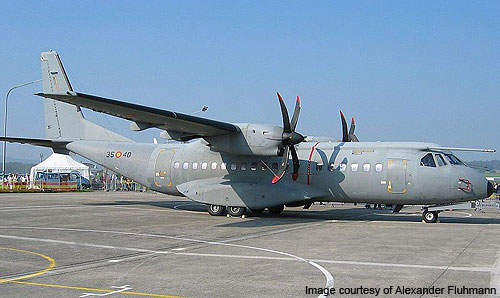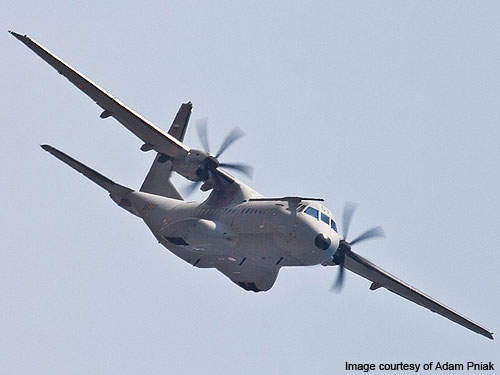The C295 MPA is a multirole maritime patrol aircraft derived from the C295 military transport aircraft. It has been developed by Airbus Military, a unit of Airbus.
Equipped with a new generation mission system, the aircraft can conduct maritime patrol, anti-submarine warfare (ASW) and anti-surface warfare (ASuW) missions.
In May 2010, Airbus Military conducted the first torpedo launch from a C295 MPA aircraft. In July 2010, the anti-submarine variant was certified by the Spanish authority INTA for its military airworthiness.
Orders and deliveries of the maritime patrol aircraft
As of November 2011, Airbus Military sold 85 C295 aircraft across 12 countries.
In October 2007, Airbus Military signed a contract with the Chilean Navy for three C295 MPAs with an option for five more. The Chilean Navy received the first of the three aircraft in April 2010. In April 2011, the Chilean Navy received the first C295 ASW after INTA certification.
In November 2011, the Mexican Air Force ordered five C295 aircraft. Four of them will be used by the Mexican Navy.
Design and features of the C295 MPA
The design of the C295 MPA is based on the airframe of C295 military transport aircraft. The design incorporates a few components in a simple system architecture to achieve weight reduction.
The landing gear is designed to allow take-off and landing operations on unprepared and short airfields. Underwing hardpoints are provided for carrying the weapon systems as well as reconnaissance / jamming pods and search lights.
The rear ramp of the aircraft allows the transport of standard 88" x 108" pallets and bulk cargo, avoiding the need to remove the operator consoles. The aircraft also supports the deployment of palletised mission systems.
It can launch search and rescue rafts, emergency equipment and parachutists.
C295 MPA missions
C295 MPA is a versatile aircraft capable of serving a range of mission requirements.
It is deployed in military transport, maritime patrol, EEZ (exclusive economic zone) surveillance, search and rescue missions (SAR), ASW, AsuW, signals intelligence (SIGINT), imagery intelligence (IMINT), law enforcement and marine pollution control missions.
Avionics systems onboard the multirole maritime patrol aircraft
The C295 MPA is fitted with an advanced integrated avionics system. The avionics suite consists of four liquid crystal displays and associated control units.
A set of geophysical sensors provide attitude, heading and air data information. Other subsystems include an AHRS (attitude and heading reference system), an ADS (air data system), a FMS (flight management system) and an automatic flight control system.
The aircraft is fitted with a fully integrated tactical system (FITS) for mission control.
The system comprises a range of sensors and components including search radar, electro-optic / infrared sensors (EO/IR), electronic support measures (ESM) / an electronic intelligence system (ELINT), COMINT, a magnetic anomaly detector (MAD), an IFF interrogator, a SATCOM, a datalink and a Link-11.
Other subsystems include acoustics systems, an automatic identification system (ais) and sea pollution detection systems.
The FITS ASW version underwent operational evaluation (OPEVAL) and conducted anti-submarine and anti-surface missions during Nato exercises.
Weapon systems of the widely used C295 maritime patrol aircraft
The C295 has up to six underwing hard points for weapon systems. The hard points can hold torpedoes, anti-surface missiles, mines and depth charges.
A C295 MPA anti-submarine variant has successfully conducted its first torpedo launch test in May 2010.
The aircraft is equipped with self-protection equipment including cockpit armour, a radar warning receiver (RWR), a missile approach warning system (MAWS) and a laser warning receiver (LWR).
The aircraft can fire chaff / flares to deceive the incoming radar-directed anti-aircraft artillery (AAA), radar command-guided missiles, radar homing guided missiles and infrared guided missiles.
The C295 MPA is powered by two PW127 turboprop engines driving Hamilton Sundstrand Type 568F-5 six bladed propellers. Each propeller has a diameter of 3.9m. The engine provides a nominal take-off power of 2,645shp.
The main landing gear is equipped with independent oleo-pneumatic type shock-absorber units retract rearwards into the fuselage. Two interconnected levered legs featuring four wheels are arranged in a tandem configuration on each side.
The nose landing gear has two wheels arranged in twin configuration. The brake system is equipped with an anti-skid control system.
Performance of Airbus Military’s C295
The C295 can fly at a maximum speed of 480km/h. The altitude during normal operations is 7,620m. The maximum takeoff weight is 23,200kg. The aircraft has an endurance of more than 11 hours and a maximum range of 5,630km.







